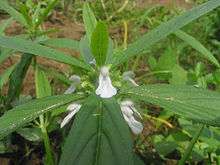Leucas zeylanica
| Leucas zeylanica | |
|---|---|
 | |
| Scientific classification | |
| Kingdom: | Plantae |
| (unranked): | Angiosperms |
| (unranked): | Eudicots |
| (unranked): | Asterids |
| Order: | Lamiales |
| Family: | Lamiaceae |
| Subfamily: | Lamioideae |
| Genus: | Leucas |
| Species: | L. zeylanica |
| Binomial name | |
| Leucas zeylanica (L)R.Br. | |
| Synonyms | |
|
Leucas bancana Miq. | |
Leucas zeylanica, commonly Ceylon slitwort[1] (Sinhala: ගැටතුඹ, Geta-tumba in Sinhala, halkusha in Bengali, Guldora in Punjabi, kulnnphul in Gujarati, Goma madhupati in Hindi, Kubo in Sindhi, Bhutamari in Oriya, Bahuphul in Marathi, Thumbai in Tamil, Thumbe in Kannada, Thummi in Telugu and Thumba in Malayalam . ), is a small, terrestrial, herbaceous, annual, erect or sometimes tufted, hispid and aromatic plant of the subfamily Lamioideae of family Lamiaceae. Botanical synonyms include Leucas bancana Miq., Phlomis zeylanica Linn. and Spermacoce denticulata Walp., and is native in Tropical Asia to Malaya.[2][3]
Description
Plant is growing to a height of up to 120 cm, stipules absent, taproot white or brown, stem quadrangular plant. Sub-sessile leaves are linear-lanceolate or elliptic-lanceolate, 2.5 to 7.5 cm long, not lobed or divided, blunt at the tip, obtuse, entire or cerrulate, glandular, hispid and coarsely dentate at the margins. Whorls of many flowers are bisexual, sessile or sub-sessile, usually in terminal whorls 1 to 2 cm in diameter, grouped together in an axillary, corolla white in color and 2 cm long. Calyx is 5 to 7 mm long, and obliquely turbinate, with minute teeth, apex acute, base acute, pinnately veined, erect or spreading horizontally. It is reproduced by seed and pollinated by bees moths and flies. Leucas belongs to the subfamily Lamioideae, and is closely related to the small genera Acrotome and Leonotis.[4][5]
Habitat
Plant occurs in various habitats, a weed of sunny dry localities, often on sandy soils, paddy dams, waste places, open grasslands, road-sides from the lowland up to 1,700 m altitude. Widely distributed throughout Southeast Asia, but is rather rare in East Asia.[6]
Constituents
Yields a small amount of essential oil on distillation. Decoction of herb boild with soda solution emits a strong odor; when condensed, the vapor yields ammonia and a volatile alkaloid in the distillate.
Uses
Culinary
The whole herb has a bitter taste, but is still used as flavoring or potherb.
Medicinal
Medicinally considered a stimulant and antirheumatic. Wild-crafted and used mainly for coughs, colds, toothaches, and abdominal pains. In China and Malaysia, poultice of leaves may be taken as a sedative, and to heal wounds and sores. Poultice also used for itches, headaches and vertigo. Bitter roots and bitter and pungent leaves used for skin diseases and for scabies. Infusion used as insecticide. A decoction of leaves and nigella seed or the fresh juice of turmeric and rice, used for as a lotion for ulcers of the nose. In Malaysia, the entire plant is rubbed on the abdomen after childbirth. In India, used for fever, scorpion and snake bites. Leaves and flowers used for jaundice. In Sri Lanka, a principle vermifuge ingredient. Used for anorexia, flatulence, colic; in mixture, used to treat malaria, for mild fevers associated with indigestion; also, for pain caused by intestinal worms.[7]
Agricultural
All of Leucas species is becoming a serious weed in rice fields, sugarcane and banana plantation.
Studies
Antibacterial / Photoactivity
In a study of 32 plants species collected from serpentine (ultramafic) soils in Sri Lanka and screened for antimicrobial properties, Zeylanica showed photo-mediated activity against Staphylococcus aureus and Bacillus subtilis. Zeylanica showed population-level variation in photoactivity. Study suggests plants from serpentine environments may have alterered antimicrobial activities compared to non-serpentine environments, and that attention is needed in deciding on the substrate and habitat when collecting plants to test for antimicrobial properties.[8]
Essential oil / Antioxidant / Antibacterial
Study of essential oil showed the major components were: oleic acid, hexadecanoic acid, 1-octenen-3-oil, caryophyllene, etc. The essential oil showed scavenging antioxidant activity. Antibacterial activity showed inhibition of test bacterial growth, especially Escherichia coli and Salmonella enteritidis.[9][10]
Common names
References
- ↑ "Leucas Zeylanica". http://www.virboga.de. Retrieved 2012-03-28. External link in
|publisher=(help) - ↑ "Leucas Zeylanica List". http://www.tropicos.org. Retrieved 2012-03-28. External link in
|publisher=(help) - ↑ "The International Plant Name Index - Leucas Zeylanica List". http://www.ipni.org. Retrieved 2012-03-28. External link in
|publisher=(help) - ↑ "Leucas zeylanica (L.) R.Br. - LAMIACEAE - Dicotyledon". http://www.oswaldasia.org. Retrieved 2012-03-28. External link in
|publisher=(help) - ↑ "Leucas zeylanica in Flora of China". http://www.efloras.org. Retrieved 2012-03-28. External link in
|publisher=(help) - ↑ "Germplasm Resources Information Network - Leucas zeylanica". http://www.ars-grin.gov. Retrieved 2012-03-28. External link in
|publisher=(help) - ↑ "Plants for use - LAMIACEAE Leucas zeylanica". http://plantsforuse.com. Retrieved 2012-03-28. External link in
|publisher=(help) - ↑ "Antimicrobial Activity of Plants Collected from Serpentine Outcrops in Sri Lanka". http://www.ingentaconnect.com. Retrieved 2012-03-28. External link in
|publisher=(help) - ↑ "Study on Essential Oil Obtained from the Seed of Leucas zeylanica". http://en.cnki.com.cn. 2009-02-16. Retrieved 2012-03-28. External link in
|publisher=(help) - ↑ "Study on Essential Oil Obtained from the Seed of Leucas zeylanica". http://www.scienceengineeringonline.com. Retrieved 2012-03-28. External link in
|publisher=(help)
External links
- Use of medicinal plants among tribes in Satpuda region of Dhule and Jalgaon districts of Maharashtra–An ethnobotanical survey
- Antimicrobial Activity of Plants Collected from Serpentine Outcrops in Sri Lanka
- The National Center for Biotechnology Information - Leucas zeylanica